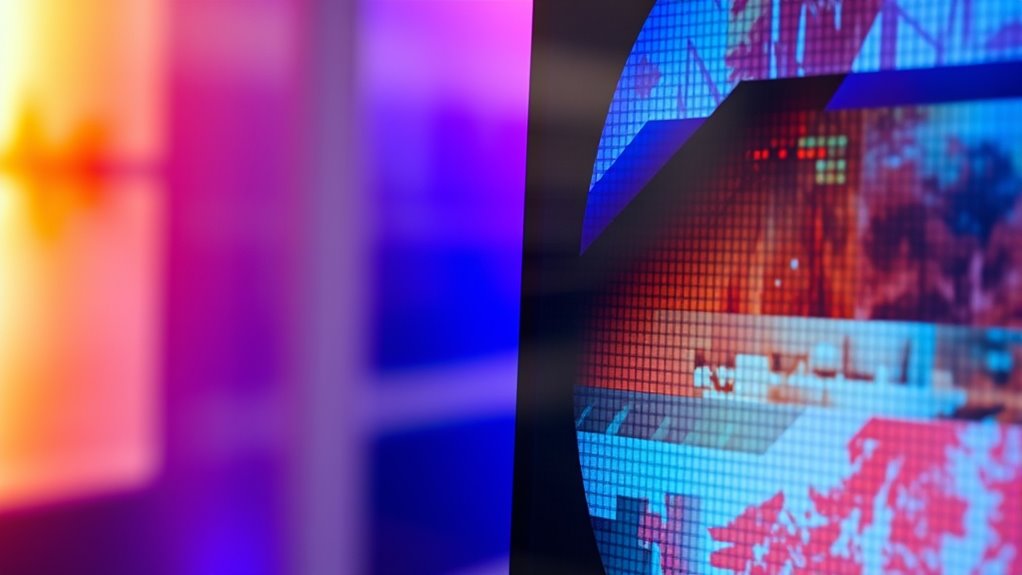Understanding quantization and bit depth helps you see how digital images display colors and shades. Quantization converts continuous tones into discrete steps, which can cause visible banding or posterization, especially in smooth gradients. Bit depth determines how many color or brightness levels an image can show; higher bit depths allow for more subtle progressions, reducing artifacts. Mastering these concepts reveals how image quality can be preserved or improved, and exploring further will give you even clearer insights.
Key Takeaways
- Quantization reduces continuous color or brightness levels into discrete steps, affecting image smoothness.
- Bit depth determines the number of possible color and brightness levels, with higher bit depths allowing more nuance.
- Lower bit depths can cause banding and posterization, especially in smooth gradients and subtle color transitions.
- Using higher bit depths and dithering techniques minimizes quantization artifacts and preserves image quality during editing.
- Understanding the balance between bit depth and compression helps maintain image fidelity and reduces visual artifacts.

When working with digital images, understanding how colors and shades are represented is essential. Your grasp of concepts like quantization and bit depth directly impacts the quality of your images, especially when it comes to color grading and managing compression artifacts. At the core, color grading involves adjusting the colors in an image to achieve a desired look or mood. The effectiveness of these adjustments depends heavily on how many shades and color nuances your image can display, which is determined by its bit depth. A higher bit depth means more bits are used for each color channel, allowing for a richer and more precise range of colors. Conversely, a lower bit depth limits this range, causing colors to appear more posterized or banded, which can be particularly noticeable in smooth gradients or subtle color transitions.
Quantization is the process of mapping a continuous range of color or brightness levels into a finite set of discrete values, which is what your digital image ultimately contains. When you save or compress an image, you’re effectively performing quantization. This process reduces the number of available shades, which can sometimes lead to visible artifacts. Compression artifacts, for example, often manifest as banding or posterization in areas that should be smooth, like skies or skin tones. These artifacts are a direct result of the quantization process, where the original subtle gradations are forced into fewer, larger steps. The more aggressive the compression, the more prominent these artifacts become, degrading your image’s overall quality. Additionally, understanding how color depth influences visual fidelity can help you make better decisions during editing and compression to preserve image quality.
The relationship between quantization, bit depth, and compression artifacts is vital to understand. When you work with higher bit depths—such as 10-bit or 12-bit—you give your images more room to display subtle changes in color and brightness. This makes color grading more flexible and reduces the likelihood of visible quantization effects. On the other hand, using lower bit depths, like 8-bit, increases the risk of banding, especially during intensive color adjustments. When compressing images, choosing formats and settings that preserve higher bit depths can help minimize visible artifacts. Techniques like dithering can also help smooth out quantization steps, making gradients appear more natural and less posterized.
Frequently Asked Questions
How Does Bit Depth Affect Image File Size?
You’ll notice that higher bit depth increases your image file size because it captures more color information, which requires more data. This can improve color fidelity but may lead to larger files and potential compression artifacts if compressed too much. Conversely, lower bit depths reduce file size but might cause color banding and loss of detail. Balancing bit depth helps you maintain quality while managing file size effectively.
What Is the Relationship Between Quantization Error and Image Quality?
You notice that higher quantization error causes more quantization noise, which degrades image quality. When the error is large, you often see color banding, especially in smooth gradients. To minimize this, you should increase bit depth, reducing quantization error. This results in smoother color transitions and less noticeable banding, improving overall image quality. So, controlling quantization error is key to maintaining crisp, high-quality digital images.
Can Increasing Bit Depth Improve Image Resolution?
Increasing bit depth doesn’t directly improve image resolution, but it enhances color accuracy by allowing more color shades, reducing banding. For example, moving from 8-bit to 12-bit color increases possible shades from 256 to 4,096 per channel. This also improves compression efficiency, as more bits mean less quantization error, resulting in higher quality images without increasing file size markedly. So, while resolution stays the same, image quality and color fidelity considerably improve.
How Do Color Spaces Influence Quantization?
Color spaces influence quantization by defining the color gamut, which determines the range of colors your device can display. A wider color gamut allows for more precise color representation, improving color accuracy during quantization. When you choose a color space with a larger gamut, your images retain more vibrant and true-to-life colors, reducing banding and color distortion. This results in better overall image quality and more accurate color reproduction.
What Are Practical Limits for Bit Depth in Consumer Devices?
Bit depth on consumer devices is like a small garden; it has its practical limits. Typically, you’ll find 8-bit displays, offering 256 levels per color, which balances quality and performance. Higher bit depths, like 10 or 12 bits, improve color accuracy but require better sensor sensitivity and precise display calibration. These limits make certain that smooth performance without overwhelming hardware, making images look vibrant yet manageable for everyday viewing.
Conclusion
Now that you’ve grasped how quantization and bit depth shape your images, remember—every pixel is a tiny universe of color and detail. When you choose higher bit depths, you’re not just enhancing images; you’re revealing their true potential, revealing vibrant worlds hidden in every shot. Don’t settle for less; embrace the power of accurate color and depth. After all, your images deserve the richness that only true understanding can bring.









